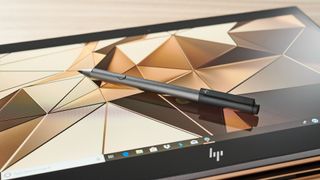TechRadar Verdict
HP has given the 13-inch Spectre x360 2-in-1 laptop a new lease on life with an attractive redesign, improved hardware and a massive boost to battery life.
Pros
- +
Stylus included
- +
Good looking new design
- +
Long battery life
Cons
- -
Expensive
- -
Minor performance gains
Why you can trust TechRadar
HP’s Spectre line is once again raising the bar with the HP Spectre x360 (2019) this time. Among the best HP laptops right now, this hybrid offering is more than just one of HP’s top-of-the-line laptops. It’s almost a work of art, touting newer components and impressive battery life in its thin, beautifully gem-cut design. And, thanks to its high-quality hinge, it’s an amazing 2-in-1 laptop as well.
The HP Spectre x360 (2019) may not be radically different from its predecessors. However, it does add enough refinements to its design and internals, allowing it to keep up with its rivals while sticking with that svelte ultrabook design and keeping the price of entry lower than that of the Dell XPS 13 and the MacBook Pro 13-inch.
It’s no wonder the HP Spectre x360 (2019) has made it to our best 2-in-1 laptops list.

Here is the HP Spectre x360 configuration sent to TechRadar for review:
CPU: 1.8GHz Intel Core i7-8565U (quad-core, 4MB cache, up to 4.6GHz)
Graphics: Intel UHD Graphics 620
RAM: 8GB DDR4
Screen: 13.3-inch FHD (1,920 x 1,080) touch panel (WLED, IPS)
Storage: 512GB SSD (PCIe, NVMe, M.2)
Ports: 2 x Thunderbolt 3 (USB-C), 1 x USB 3.1, 1 x microSD, 1 x 3.5mm audio jack
Connectivity: Intel 802.11 b/g/n/ac Wi-Fi, Bluetooth 4.2
Camera: HP TrueVision FHD IR webcam
Weight: 2.93 pounds (1.33 kg)
Size: 12.16 x 8.58 x 0.58 inches (30.88 x 21.79 x 1.47cm; W x D x H)
Price and availability
Just like HP’s laptops, there is a quite a few different configurations for the 13-inch HP Spectre x360 (2019) with various specifications and prices to match. The base model comes equipped with an Intel Core i5-8265U processor, 8GB of RAM, 256GB PCIe SSD and a full HD (1080p) IPS touchscreen. This sells for $1,010 (£1,199, AU$2,499).
For the HP Spectre x360 loaded with an Intel Core i7-8565U and 512GB of PCIe SSD storage (with the rest of the specs the same), the price tag rises to £1,399. In the US and Australia, the RAM gets bumped up to 16GB for $1,330 (AU$2,799).
The US also has a configuration similar to the previous one but with a less speedy Intel Core i7-8550U processor for $1,180. Meanwhile, in Australia, you can get a Spectre x360 with the same components as above, but with a 1TB PCIe SSD for AU$2,999.
If you’re after a 4K screen, 16GB of RAM and 1TB PCIe storage, the price is £1,699. In Australia, you can get a 4K display, Core i7-8565U processor and 16GB RAM, but just a 512GB PCIe SSD for AU$3,399. It looks like this configuration is currently not available in the US.
Things are a little different in Australia, where there are two models that aren’t available in the US and UK. Both of these models include SIM card ports for using 4G mobile broadband. The first model costs AU$3,199, and includes an Intel Core i7-8565U, 8GB of RAM and a 512GB M.2 SSD. You can upgrade that up with 16GB of RAM and a 1TB SSD for AU$3,799.
There are also 15-inch models of the HP Spectre x360, equipped with a faster Intel Core i7-8750H processor. We have reviewed that model separately here: HP Spectre x360 15T (2019).
No matter whatever specs are most suited for you, it will be easy to find one of the HP Spectre x360 that fits you best. Though to make matters more confusing, not every configuration of the Spectre x360 is available in all markets, so you may find your choice slightly narrowed depending on where you live.

Design
While it is slightly larger than last year’s model, the revamped look of the HP Spectre x360 (2019) makes it a far more attractive 2-in-1 than its 2018 predecessor.
The design of the HP Spectre x360 (2019) has profited from some subtle changes compared to 2018’s model, most noticeably at the top left and right corners, which are now diagonal, giving the Spectre x360 a more unique look.
On the left-hand corner sits the power button, and the right sports an additional USB-C port. The speaker grille that runs along the top of the keyboard has an updated, slick design, and the speakers behind it are again supplied by Bang & Olufsen.
A new addition, the fingerprint scanner sits on the right-hand side right below the keyboard. This allows you to log into Windows quickly and easily by placing your finger on the sensor. The touchpad is centered below the keyboard, and it’s large enough for comfortable use.
However, in daily use, the touchpad isn’t quite as responsive as we would like, though on the whole it does fine with multi-touch gestures. Still, it isn't quite as smooth as the touchpads we’ve used on other laptops.

The keyboard, on the other hand, is much better executed. Despite the HP Spectre x360’s slim form factor, the keys offer enough travel to feel responsive and satisfying when pressed. There’s no numpad, but that allows HP to spread the remaining keys across the length of the Spectre x360, and they are decently sized, which is helpful to fast typers.
This also means that in laptop mode, the HP Spectre x360 (2019) continues to be a comfortable device to work on for extended periods of time. You might just want to pick up in an external mouse, rather than rely on the touchpad.
On the left-hand side is a single full-size USB-A 3.1 port, which is a nice inclusion as many of us still have devices not equipped with a USB-C port. Having this standard USB port means you can use older hardware without needing a dongle.
On the right-hand side are two USB-C ports – with one located on the diagonal corner of the HP Spectre x360 (2019)’s body. This is quite a strategic location to have it, as it means any peripherals (or the USB-C power cable) are angled away from you when in use.
Additionally, there’s an audio jack port, microSD port and a physical switch so you can disable the webcam, which again is a nice touch for privacy-conscious consumers.
As with all of HP’s x360 models, the HP Spectre x360 is a laptop furnished with a 360-degree hinge for its screen, which allows it to be used as a transitional laptop, as well as rotating it all the way back to be transformed into a tablet-like device. You can also set it up in tent mode (as an inverted V) and use it to watch media on.
The HP Spectre x360’s top-notch build quality means that the hinge feels solid when used, so you won’t have to worry about damaging it while you angle the screen into a variety of positions.
The laptop's 30.88 x 21.79 x 1.47cm (W x D x H) dimensions and 1.33kg weight make it effortless and comfortable to carry around, and it’s not that much bigger (or thicker) than last year’s model at 30.6 x 21.8 x 1.36cm and 1.26kg. Yes, the Spectre x360 is getting larger and heavier, but only by a little, and considering the specs upgrade (which we’ll get to in a bit), that trade-off isn’t too bad.

Screen and stylus
HP also seems to have improved the display since last year’s model, with the HP Spectre x360 (2019)’s screen looking much brighter and more dynamic than its predecessor. Our review model came with a 1,920 x 1,080 Full HD display that’s 13.3 inches in size.
The display is protected by Corning Gorilla Glass NBT, which is essential for any 2-in-1 device to safeguard it from being damaged when in tablet mode. Naturally, it’s a touchscreen, and it works fine when you’re using a finger, though the HP Spectre x360 (2019) also comes equipped with a stylus (more on that in a moment) at no extra cost.
The screen panel utilizes in-plane switching (IPS) technology, which offers wide viewing angles. Since you can rotate the screen to set it in various configurations, this ensures that image quality remains high no matter what the angle the screen is positioned.
The HP Spectre x360 (2019) also has the HP Sure View technology built in. By switching this mode on, you can drastically limit the viewing angles, which is useful if you’re working in public spaces, as it makes whatever is on the screen hard to see if you aren’t sitting directly in front of it.
This feature can be turned on and off using the F1 button on the keyboard, and it works incredibly well, with the screen looking extremely washed out and unreadable when looked at from any angle. Looking at the screen head-on, the image is a little more washed out than usual, but still perfectly usable. Not many people will ever use this feature, but it’s still nice to have and works well.
There are also models of the HP Spectre x360 (2019) that come with a 4K screen. For many folks, a 4K screen on a 13-inch laptop might be a little too much. Still, it’s a welcome option. Though, as we mentioned earlier, the 4K option isn’t available in all markets.

In action, the screen does more than a credible job of displaying apps and media. Though it isn’t the brightest screen we’ve seen on a laptop, it does its job well.
It’s worth mentioning that HP Spectre x360 (2019) has large bezels along the top and bottom of its display. It’s too bad as we’re used to laptops at this price point having extremely thin bezels - such as the Dell XPS 13, which gives you the most screen real estate possible while looking sleek and modern. In comparison, the big bezels on the HP Spectre x360 (2019) display feel a bit out of date.
The HP Spectre x360 (2019) also comes with the HP Active Pen stylus. It’s a sturdily-built device that feels great to handle and works swimmingly with the x360’s touchscreen. The fact that HP has included it with the Spectre x360 at no extra cost, when many of the other manufacturers don’t, could and should be a major selling point.
First reviewed March 2019
Images Credit: TechRadar

Matt is TechRadar's Managing Editor for Core Tech, looking after computing and mobile technology. Having written for a number of publications such as PC Plus, PC Format, T3 and Linux Format, there's no aspect of technology that Matt isn't passionate about, especially computing and PC gaming. Ever since he got an Amiga A500+ for Christmas in 1991, he's loved using (and playing on) computers, and will talk endlessly about how The Secret of Monkey Island is the best game ever made.

I just saw what Half-Life 2 should look like in 2024, and I've changed my mind about Nvidia’s RTX Remix tool

Honda unveils a series of sleek EVs for China and they're way more exciting than anything we get in the rest of the world

A whole new generation of ransomware makers are attempting to shake up the market
